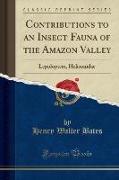Contributions to an Insect Fauna of the Amazon Valley
BücherAngebote / Angebote:
Excerpt from Contributions to an Insect Fauna of the Amazon Valley: Lepidoptera, Heliconidae
There is a very wide dissimilarity in minor points and in general appearance between the Asiatic set of forms and the American: the only Old World genus which at all approaches the New World group is Hmnadryas, but the shape, colours, and neuration of the wings show that it has no close affinity with them. The two sets of forms seem to agree, however, in habits, and apparently occupy the same sphere in the economy of nature in their respective countries. Mr. Wallace, who has had the good fortune to observe both in their native abodes, says, the habits of the South Asian Euplaece (the most numerous genus) are precisely those of the Helicom'daz. The Asiatic Dcmaidce are mostly above the middle size, and include some of the largest Butter¿ies known, their American equivalents are in general below the middle size. Both are extremely prolific or abundant in individuals, and are amongst the most characteristic productions of their respective countries. Each set, also, are the objects of numerous mimetic resemblances on the part of other Lepidopterous insects of their own region belonging to different families, - the Asiatic mimickers being modelled after the Asiatic sm'dce, and the American after the American members of the same family.~ The entire dissimilarity of the two sets of forms would seem to teach us that there can have been no land com munication east and West between the tropical parts of Asia and America since they first came into existence, and therefore that the great continents must have remained separate in those quarters from a very remote epoch to allow for such an extensive independent development of forms. They are both strictly confined to the hottest parts of their respective hemispheres. In America they are not found beyond the northern tr0pic, nor much further south than 30° 8. Lat. They are not known to occur so far from the equator as either trepic in the Old World, but are limited to the south-eastern parts of Asia and the islands of the New Guinea group. The genus sais, with which we have seen both groups are connected, ranges as far north as 41° in Europe, and 45° in North America. It is interesting thus to find that the only genus which is common to the three tropical regions is the sole one of the family that occurs in high latitudes. The only means of communication between the intertropical lands of America and Asia seems to have been a circuitous route by the north (or south), and the essentially tropical forms do not appear to have passed along it. The fact of the peculiar equatorial Asiatic dorm/[irma not reaching Africa is explicable on the same grounds as their entire distinct ness from the American ones, namely, the non-existence of an equatorial connexion of land of a nature suitable for their transit between the two continents since the remote date when the first forms of the group came into being.
About the Publisher
Forgotten Books publishes hundreds of thousands of rare and classic books. Find more at www.forgottenbooks.com
This book is a reproduction of an important historical work. Forgotten Books uses state-of-the-art technology to digitally reconstruct the work, preserving the original format whilst repairing imperfections present in the aged copy. In rare cases, an imperfection in the original, such as a blemish or missing page, may be replicated in our edition. We do, however, repair the vast majority of imperfections successfully, any imperfections that remain are intentionally left to preserve the state of such historical works.
Folgt in ca. 5 Arbeitstagen
